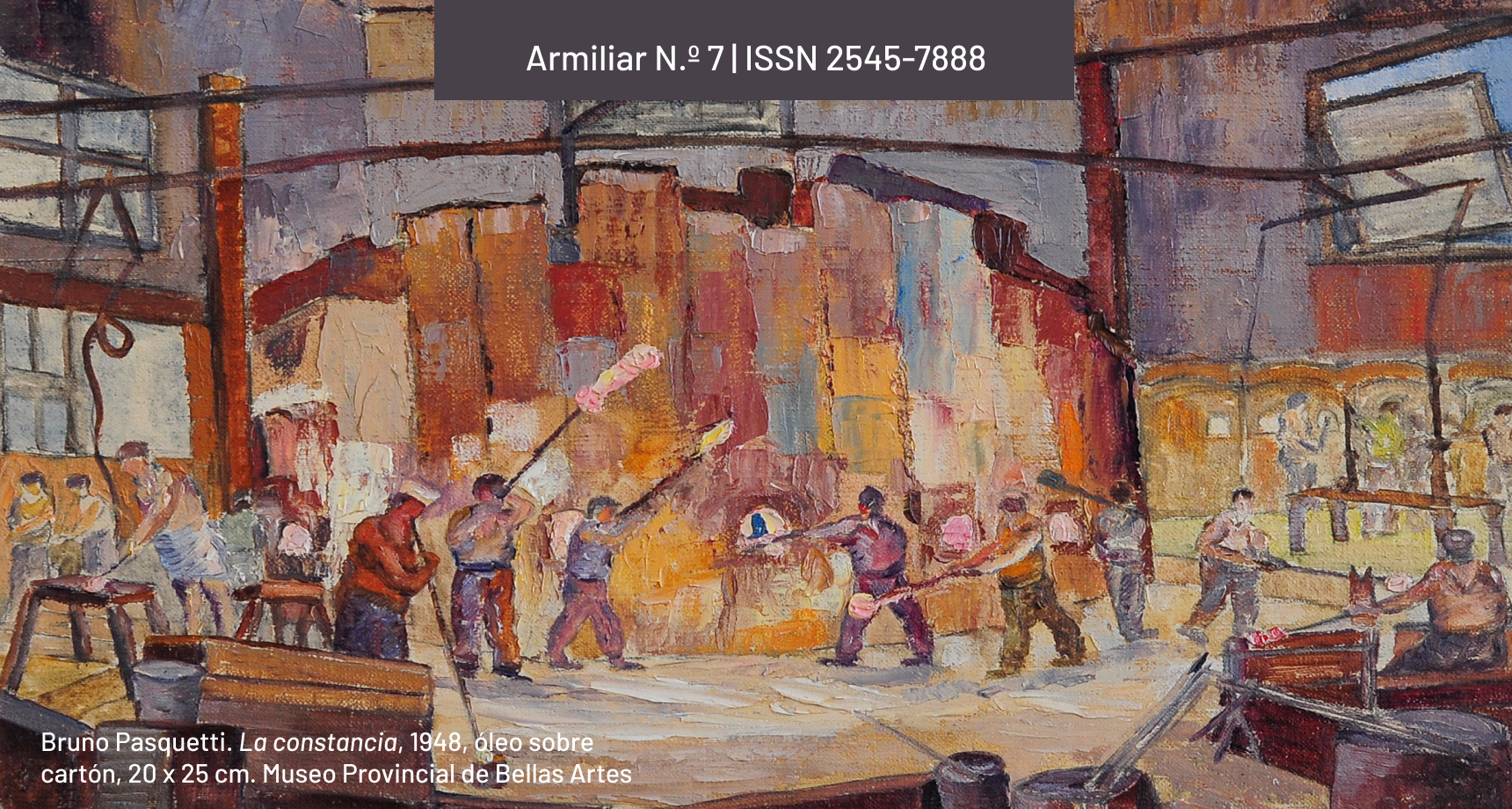The National Commission of Fine Arts and the European journey: a start point to the creation of a National Academy (1897-1908)
DOI:
https://doi.org/10.24215/25457888e047Keywords:
National Commission of Fine Arts, Academy, Argentina, Artistic Pensions, Early 20th CenturyAbstract
The origins of Argentina’s artistic-institutional history can be traced back to the foundation of a private institution, the Sociedad Estímulo de Bellas Artes, in Buenos Aires in 1876; while the National Academy of Fine Arts was not established until 1905. Previous research has mainly focused on the almost organic continuity between the two institutions. In contrast, this paper will emphasize the role played by the establishment of the Comisión Nacional de Bellas Artes (1897) in the formation of a governmental institution for artistic education, which was founded to regulate pensions for artistic studies abroad.Downloads
References
Academia Nacional de Bellas Artes y Escuela de Artes Decorativas e Industriales 1878-1928. (1927). Imp. José Fornarese.
Baldasarre, M. I. (2016). La educación de los artistas. En L. Malosetti Costa (Ed.), Ernesto de la Cárcova (pp. 51–62). Asociación Amigos Museo Nacional de Bellas Artes.
Baldasarre, M. I. (2020). Between Buenos Aires and Europe Cosmopolitanism, Pensionnaires, and Arts Education in Late 19th Century Argentina [Entre Buenos Aires y Europa: cosmopolitismo, pensionados y educación artística en Argentina a fines del siglo XIX]. En O. E. Vázquez, Academies and Schools of Art in Latin America (pp. 17–32). Routledge.
Comisión Nacional de Bellas Artes. (1899). Reglamento de los Concursos de Pintura, Escultura y Música para optar a las subvenciones para estudios en Europa—Aprobado por decreto de fecha 10 de Julio de 1899. Ministerio de Justicia e Instrucción Pública; AS-MNBA.
Comisión Nacional de Bellas Artes. (1909, julio 16). Boletín Oficial de la República Argentina, 331. Decreto firmado por el presidente José Figueroa Alcorta y el ministro de Instrucción Pública Rómulo S. Naón
Corsani, P. (2021). Hacer esculturas. Proyectos, técnicas, materiales y realizaciones. Buenos Aires (1880-1904). Prohistoria.
Fasce, P. (2021). Del taller al altiploano. Museos y academias artísticas en el Noroeste argentino. Unsam Edita.
Losada, L. (2010). Esplendores del Centenario: Relatos de la elite argentina desde Europa y Estados Unidos. Fondo de Cultura Económica.
Malosetti Costa, L. (2006). Collivadino (Ateneo).
Malosetti Costa, L. (2008). Cuadros de viaje. Artistas argentinos en Europa y Estados Unidos (1180-1910). Fondo de Cultura Económica.
Malosetti Costa, L. (2021). Los primeros modernos. Arte y sociedad en Buenos Aires a fines del siglo XIX (primera edición 2001). Fondo de Cultura Económica.
Mantovani, L. (2023). El pueblo tiene derecho a la belleza: Artes aplicadas, educación e industria en Buenos Aires (1910-1940) ([en prensa]). Miño y Dávila.
Mantovani, L., y Murace, G. (2017). “Enseñar en las fábricas el amor a lo bello”. Artes industriales y academia a comienzos del siglo XX en Argentina. En A. Cavalcanti, M. Malta, S. Gomes Pereira, & A. Valle (Eds.), Modelos na arte. 200 anos da Academia de Belas Artes do Rio de Janeiro (pp. 372–387). EBA/UFRJ.
Manzi, O. (s/f). Sociedad Estímulo de Bellas Artes. Desde su fundación hasta la nacionalización de la academia. Atenas.
Muñoz, M. Á. (1998). Un campo para el arte argentino. Modernidad artística y nacionalismo en torno al Centenario. En D. Wechsler (Ed.), Desde la otra vereda. Momentos en el debate por un arte moderno en la Argentina (pp. 43–82). Ediciones del Jilguero.
Murace, G. (2022). Roma desde el Río de la Plata: Artistas argentinos y uruguayos en viaje (1890-1914). Universidad Nacional de San Martín.
Murace, G. (2023). Diálogos rioplatenses. Buenos Aires, Montevideo y la creación de una academia moderna a comienzos del siglo XX. Arte, Individuo y Sociedad, Avance en línea, 1–18. https://doi.org/10.5209/aris.84954
Nacionalización de la Academia de Bellas Artes y Escuela de Artes Decorativas e Industriales. (1905). Taller Tipográfico Barause y Lacasse.
Nusenovich, M. (2015). Arte y experiencia en Córdoba en la segunda mitad del XIX. Universidad Nacional de Córdoba.
Ripamonte, C. P. (1926). Janus. Consideraciones y reflexiones artísticas. M. Gleizer.
Suasnábar, G. (2019). De salones e instituciones en el espacio bonaerense. Prácticas artísticas entre La Plata, Mar del Plata y Tandil 1920-1955 [Tesis de doctorado, Universidad Nacional de San Martín]. https:// ri.unsam.edu.ar/handle/123456789/761
Welti, E. (Ed.). (2020). Arte, educación y cultura: Rosario 1930-1950. Laborde libros editor.
Zarlenga, M. (2014, septiembre). La nacionalización de la Academia de Bellas Artes de Buenos Aires (1905-1907). Revista Mexicana de Sociología, 76(3), 383–411
Downloads
Published
How to Cite
Issue
Section
License

This work is licensed under a Creative Commons Attribution-NonCommercial-ShareAlike 4.0 International License.
Current policy since 2019
The acceptance of the manuscript by the magazine means the non-exclusive cession of the property rights of the authors in favour of the editor, who allows the reuse, after publication (post print), under a license Attribution-NonCommercial-ShareAlikes 4.0 International (BY-NC-SA 4.0).
According to these terms, the material can be copied and redistributed by any means or in any format as long as a) the author and original source of the publication are quoted (magazine and URL of the work), access to the license is provided and whether changes have been made is mentioned; and b) the material is not used for commercial purposes.
The cession of non-exclusive rights means that after the publication (post print) in Armiliar the authors can publish their work in any language, means and format; in such cases it must be mentioned that the material was originally published in this magazine. Such cession also means the authorization of the authors for the work to be collected by SEDICI, the institutional archive of the Universidad Nacional de La Plata, and to be spread in the databases that the editorial team considers appropriate to increase the visibility of the publication and its authors.
Moreover, the magazine encourages the authors to deposit their productions in other institutional and thematic archives under the principle that offering the society the scientific and academic production without any restrictions contributes to a greater exchange of the global knowledge.



























